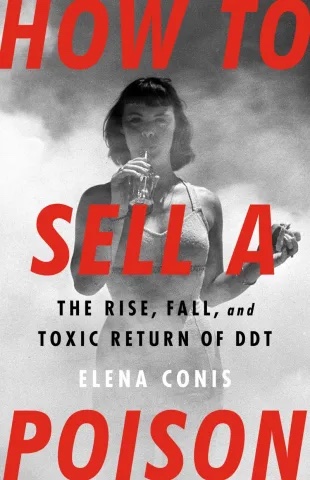
By Elena Conis
Bold Type Books, 2022
388 pages, hardcover, $30
“How to Sell a Poison: The Rise, Fall and Toxic Return of DDT” by writer and medicine historian Elena Conis is a meticulous chronicle of the complex forces that brought the insecticide DDT into prominent use, eventual disuse, and more recent resurgence. Though DDT is the focus of Conis’ research, ultimately, this is a story about the social, economic and political entanglements of science. Told as a gripping narrative of promise and disappointment, with tense courtrooms and research epiphanies, it is an excellent read. Though, at times I struggled to keep track of all of the people, organizations and research projects woven throughout and could have used a map or infographic to illustrate the many pieces of the larger DDT picture.
Created during World War II, DDT gave an edge to the U.S. military in its ability to kill insects, from mosquitos to bedbugs. It was hailed as a safe and powerful wonder of modern science, and DDT entered the consumer marketplace post-war. DDT was sprayed and dusted onto crops, livestock and mattresses; impregnated into wallpaper, plywood, cleaning solutions and fake flowers; and misted throughout city streets. Some proponents even demonstrated DDT’s “safety” by eating it.
Despite its effectiveness as an insecticide (though with limitations over time due to eventual DDT resistance), changes in the health of people and the environment were happening. With momentum from Rachel Carson’s 1962 book “Silent Spring,” which brought to light the damaging effects of DDT, as well as tireless efforts by scientists and organizations, from the United Farm Workers to grassroots environmental organizations, by 1972 restrictions on DDT were being put in place. For two decades, DDT use declined — but not without opposition.
Some scientists had concerns about the consequences DDT bans would have on communities that suffered from high rates of malaria in less developed parts of the world; such bans were seen as a form of imperialism. Simultaneously, chemical and tobacco companies deployed powerful public relations firms to recast research that posed a threat to business, an effort which, like persistent toxic chemicals in the environment and our bodies, continues to pollute.
Even though DDT use had been on the decline, in 2006, in part due to the U.S. Agency for International Development and the World Health Organization stating that DDT was “one of the best tools we have against malaria,” global DDT use doubled from 2002 levels.
Conis demonstrates that science has been and continues to be a site where societal inequities, political differences and economic interests play out, reminding us that it is often the bodies and wellbeing of marginalized communities that carry the heaviest burdens. As I write this, areas of the Penobscot River have levels of DDT, PCBs (polychlorinated biphenyls) and dioxins so high that people should not eat more than two fish harvested from its waters per month. People everywhere, including in Maine, continue to live in the shadow of DDT.
Catherine Preston-Schreck, Bar Harbor, Maine
